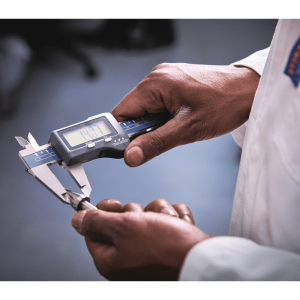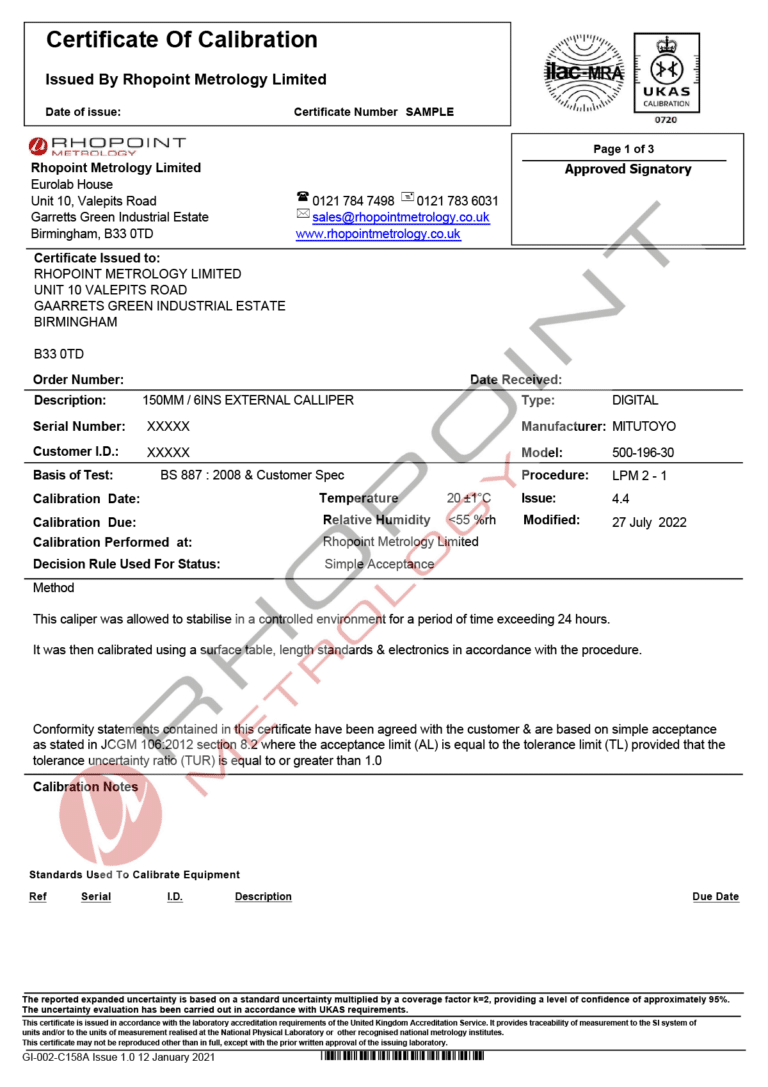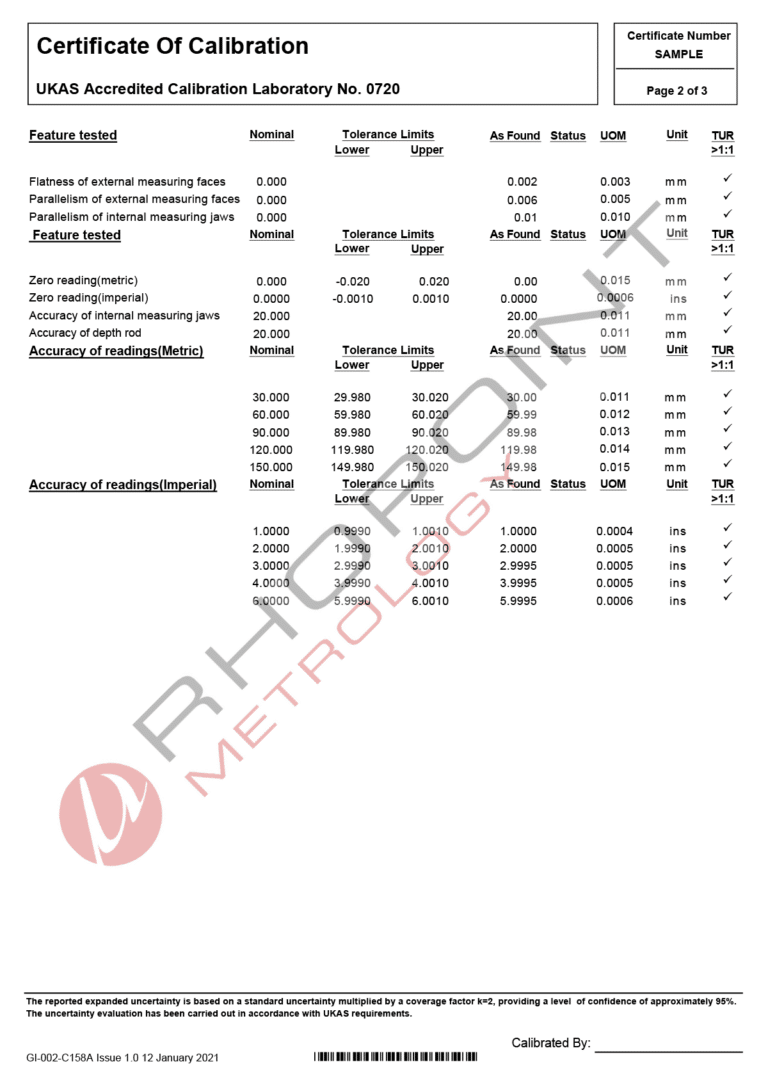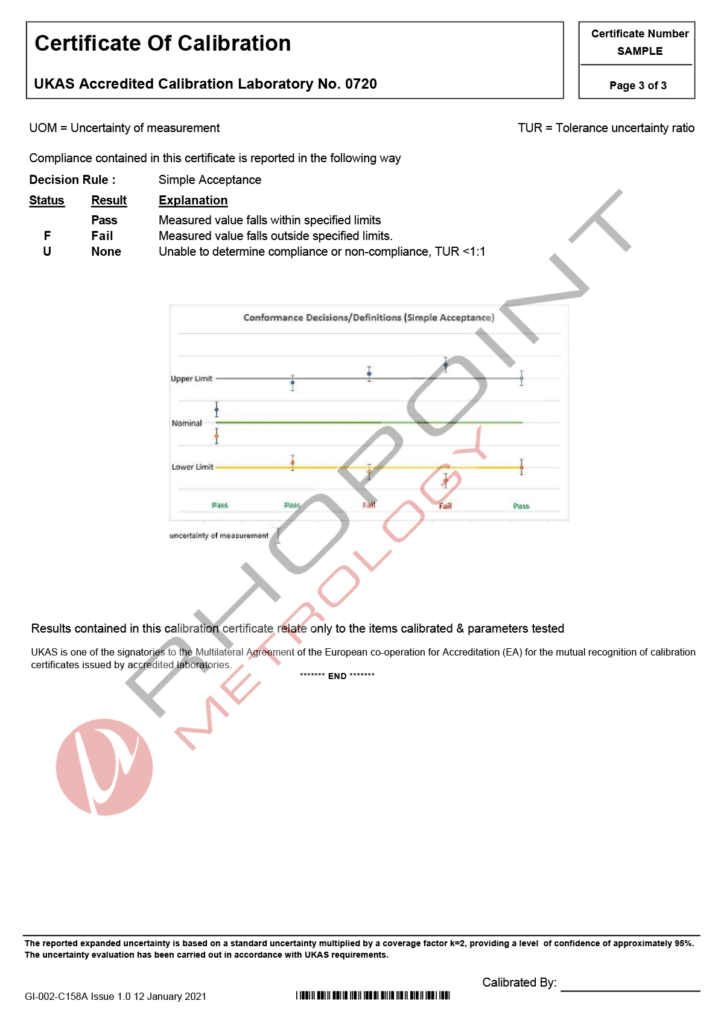
Vernier calipers are essential precision instruments used for measuring internal and external dimensions, as well as depths, with high accuracy.
Accurate vernier calipers are vital for precise measurements in manufacturing, engineering, and quality control processes. Calibration helps prevent measurement errors, supporting overall quality assurance efforts.
Rhopoint Metrology offers ISO 17025 certified calibration for vernier calipers, thereby ensuring precision, compliance, and peace of mind, supporting your commitment to quality and operational excellence.
Our services are available onsite or at our laboratories based in Birmingham and Bristol.
Enquire now for pricing.
Vernier CalipersTo Top | ||||
| UKAS Calibration for Vernier Gauges (Inc Digital & Dial ) – Calipers – 150 mm (6″) | UKAS | Add to Quote | ||
| UKAS Calibration for Vernier Gauges (Inc Digital & Dial ) – Calipers – 200 mm (8″) | UKAS | Add to Quote | ||
| UKAS Calibration for Vernier Gauges (Inc Digital & Dial ) – Calipers – 300 mm (12″) | UKAS | Add to Quote | ||
| UKAS Calibration for Vernier Gauges (Inc Digital & Dial ) – Calipers – 450 mm (18″) | UKAS | Add to Quote | ||
| UKAS Calibration for Vernier Gauges (Inc Digital & Dial ) – Calipers – 600 mm (24″) | UKAS | Add to Quote | ||
| UKAS Calibration for Vernier Gauges (Inc Digital & Dial ) – Calipers – 900 mm (36″) | UKAS | Add to Quote | ||
| UKAS Calibration for Vernier Gauges (Inc Digital & Dial ) – Calipers – 1000 mm (40″) | UKAS | Add to Quote | ||
| Traceable Calibration for Vernier Gauges (Inc Digital & Dial ) – Calipers – 1200 mm (48″) | Traceable | Add to Quote | ||
| Traceable Calibration for Vernier Gauges (Inc Digital & Dial ) – Calipers – 1500 mm (60″) | Traceable | Add to Quote | ||
| Traceable Calibration for Vernier Gauges (Inc Digital & Dial ) – Calipers – 1800 mm (72″) | Traceable | Add to Quote | ||
| UKAS Calibration for Digimatic Scale & Digital Readout | UKAS | Add to Quote | ||
| Traceable Calibration for Vernier Gauges (Inc Digital & Dial ) – Calipers – 2400 mm (96″) | Traceable | Add to Quote | ||
If you haven’t found the calibration you require or need some further assistance with your requirement, contact us using this form and we can find the solution you are looking for.
To ensure we can promptly address your calibration enquiry, please complete the form with all the necessary details. This will help us to provide you with accurate and timely assistance.
For urgent enquiries, please contact us directly via phone at:
It is necessary that any person carrying out such calibration work should have received appropriate training and have shown the ability to be confident via a suitable training authority. Training records should be held and maintained.
This standard covers vernier gauges with external and internal contact faces from 0 – 48″/0 -1000mm. Metric calipers measure lengths up to a maximum of 1000mm using a main scale and vernier scale graduated to read to 0.02mm. Imperial calipers measure lengths up to a maximum of 48″ using a main scale and vernier scale graduated to read to 0.001″. It may be uneconomical for any company or institution to invest in equipment to the level required in order to calibrate vernier calipers fully in accordance with the standard.
It is highly recommended that an appropriate authority such as a UKAS approved laboratory carries out a full calibration on vernier calipers at least once a year. In between UKAS calibrations at a frequency based on usage vernier gauges should be calibrated in-house. A typical in-house calibration would include a written procedure and an associated calibration record sheet which would contain as a minimum the following listed information:
(a) Serial number
(b) Location
(c) Procedure number
(d) The flatness of external measuring jaws
(e) The parallelism of external measuring jaws
(f) The parallelism of internal measuring jaws
(g) Linearity of the measuring scale
(h) Results
(i) Measurement uncertainty
(j) Sentence if appropriate
(k) Date and calibrators signature
(l) Traceability to National Standards
It is necessary that any person carrying out such calibration work should have received appropriate training and have shown the ability to be confident via a suitable training authority. Training records should be held and maintained.
The following is a layout for a typical in-house calibration for a 0 – 150mm vernier caliper.
Calibration to be carried out in accordance with in-house procedure number …………………..
Information includes:
Serial Number: Make:
Calibration Date: Range:
| FEATURE EXAMINED | SPEC (METRIC) | SPEC (IMPERIAL) | MEASURED RESULTS (METRIC) | MEASURED RESULTS (IMPERIAL) |
|---|---|---|---|---|
| Zero reading as received | ||||
| Parallelism of internal measuring jaws | ||||
| Flatness of external measuring jaws | ||||
| Parallelism of external measuring jaws | ||||
| Combination width of measuring jaws | ||||
| Accuracy of readings |
The vernier caliper was mechanically and visually inspected for mechanical performance, damage, wear and missing parts and the following faults were noted:
UKAS certification would also detail a measurement uncertainty in accordance with the schedule.
Calibrators Signature: ………………………………….
A traceability statement in this section would be required for all items and their relevant certification utilised for the calibration of the vernier caliper.
Below is a layout for a typical in-house calibration for a vernier caliper gauge.



All of our Laboratories are accredited to provide UKAS & Traceable calibrations to all the relevant standards giving you peace of mind.
Make consistent, accurate and reliable measurements
Ensure longevity of the measuring instruments
Ensure safety in critical applications such as medical and aerospace